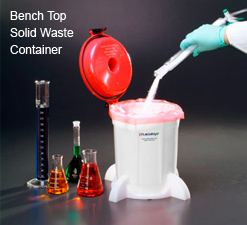EPA Definition of Solid Waste RCRA
Author’s note: In order to understand RCRA and "solid waste" regulations, it's important to know the EPA definition of hazardous waste. Familiarize yourself with the definition of solid waste and hazardous waste to get the most out of this summary.
Overview:
The Resource Conservation and Recovery Act of 1976 (RCRA) was created in a joint effort of the states and the U.S. Environmental Agency to help regulate hazardous waste disposal. RCRA is designed to uphold the practice of “cradle-to-grave” operations that impose management requirements on generators and transporters of hazardous waste as well as the owners and operators of treatment, storage and disposal (TSD) facilities. In essence, under the EPA’s definition of ‘solid waste’, companies and individuals who generate hazardous waste must follow the regulations laid out by RCRA to avoid fines and to contribute to a healthier environment.
The policy goals and objectives of RCRA state that, as a matter of national policy, generation of hazardous waste should be minimized and eliminated as quickly as possible, keeping landfill disposal at the bare minimum. Hazardous waste should also be handled is such a way it does not pose a threat to the health of people and the environment. The national objectives for RCRA include minimizing hazardous waste generation and disposal, encouraging proper waste management (i.e. prohibition of open dumping,) assumption of RCRA by the states, research and development, and encouraging hazardous waste recovery, recycling and treatment.
According to the EPA, what is Hazardous Waste? What is ‘Solid Waste’?
In order for waste to be classified as Hazardous Waste (and therefore regulated under RCRA) it must first be defined as ‘solid waste.’ The term ‘solid waste’ can have differing definitions, but for the sake of RCRA the definition provided by the EPA will be used.
The multiple classifications and types of ‘solid waste’ defined by the EPA becomes convoluted quickly, since the definition is somewhat vague, and the term can refer to non-solid wastes (such as liquids) in certain circumstances.
What is "Cradle-to-Grave"?
Generators who produce regulated hazardous waste must comply with a set of standards for handling the waste properly from beginning of its life all the way to the end, including careful tracking of shipments to the grave (or in this case, to the treatment, recycling or disposal (TSD) facilities.) Transporters of hazardous waste have their own set of regulations which deal with the manifests, labeling and delivery, alongside the requirement to comply with all U.S. Department of Transportation rules. Once hazardous waste is delivered, the TSD facility must comply with performance standards including: Statutory Minimum technology requirements, groundwater monitoring, air emission controls, corrective actions, and prohibitions on the land disposal of untreated hazardous wastes.
Generators of Hazardous Waste and RCRA
It is of the utmost importance that generators of hazardous waste take the initial steps to identify and initiate a system of management or they could be out of compliance with the “cradle-to-grave” initiative. In order to do so, generators must create a Uniform Hazardous Waste Manifest which acts as a control and transport document that accompanies the hazardous waste at all times. The manifest must contain the EPA number of the transporter, the TSD facility the hazardous waste is being transported to, a description of the waste in accordance with DOT regulations, verify it is labeled and packaged correctly, include an emergency phone number, and have the document signed by hand.
Generators cannot maintain hazardous waste on-site without a RCRA storage permit unless:
- The generator can accumulate up to 55 gallons of hazardous waste at or near the point of generation in "satellite accumulation areas." The containers must be properly marked and moved into storage once at the 55 gallon capacity.
- The generator can store hazardous waste on-site temporarily for shipment up to 90 days in proper RCRA approved storage containers. If this is the case, there must be personal training, contingency planning and emergency preparedness and response on site.
This only covers some of the key regulations that waste generators need to follow. Visit the EPA website on RCRA for more details.

